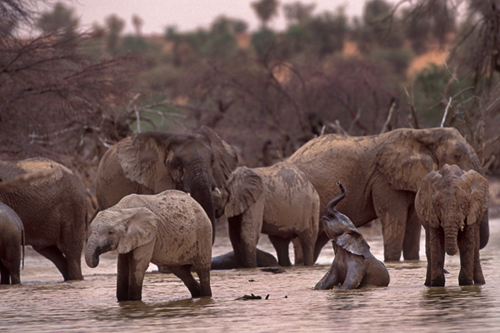
The Gourma elephants are the most northerly elephants in Africa, a remnant of the vast herds that once occupied an area of West Africa stretching from the Atlantic forests to the Sahara. Now an endangered species, the elephants of the Gourma – an area between Timbuktu and Gao – survive the harsh arid conditions of the Sahel by following a unique migratory path that takes them to Burkino Faso and back across an area of 32,000 square kilometers in search of food and water.
Thanks to a combination of remote location, the benign attitude of the local population, conservation efforts and the small, poor quality of their tusks the Gourma elephants have largely been spared the intense poaching experienced by other elephant populations in Africa. However drought, climate change and increased competition for water from the local populations and their livestock have significantly reduced their number. The recent political instability and fighting in Mali have threatened to jeopardize their survival still further.
Last year’s occupation of northern Mali by Islamist fighters and Turaeg separatists was been accompanied by a disturbing increase of poaching. “We had not experienced poaching until last year when six elephants were killed,” says Dr Susan Canney, Project Leader of the Mali Elephant Project. “Poaching has increased in order to raise funds for the rebels through the sale of ivory, or for food.” Of the six elephants only one was killed for food, the meat probably taken over the border to Burkina Faso where elephant meat is eaten. Some parts of Africa have seen instances where elephant nipples and genitals have been cut off by poachers. This practice, thought to be fueled by the Chinese market, has not occurred in Mali.
Another danger facing the Gourma elephants is one posed by unexploded munitions left over from the recent military operation. Earlier this month UNICEF reported that ammunition and explosive devises left over from the fighting had claimed 7 lives and injured 53 people.
Preliminary field reports for the United Nations Mine Action Service suggest that large quantities of explosive remnants of war – including unexploded and abandoned ammunition such as artillery shells, mortars, rockets, grenades, bullets and aircraft bombs – have been left behind in the aftermath of air attacks and ground operations. The highest concentration of these munitions is likely to be found in areas where heavy fighting took place such as in Diabaly, Douentza, Konna and Gao: areas which fall close to or within the Gourma elephant range.
So far there have been no reported incidents of injuries to elephants. It also appears that concerns that the elephant’s normal activities and migratory patterns might have been disrupted by the fighting did not materialize. Unlike elephants in other parts of Africa or India, Gourma elephants are extremely shy of human contact. They have a very acute sense of sound and smell, with the ability to hear infrasonic sounds, detect seismic vibrations and pick up smells over distances of several miles. This not only allows them to communicate in the desert and sniff out water or food but also gives them a useful early warning of approaching danger.
At the height of the Operation Serval, with helicopters, jets and troops crossing the region, Ganame Nomba, project field manager for the Mali Elephant Project, noticed that elephants in the Gossi corridor to the north-east of the elephant range seemed agitated and were moving around much more than usual. Now that these military maneuver have ended this is no longer the case. However concerns remain both about the presence of fighters in the region and of the environmental impact of the returning refugees.
Having survived the harsh conditions of the desert and peacefully and coexisting alongside the local populations for centuries, the current political instability and its consequences is yet another stress to this elephant population, already at the limit of its endurance.
According to Dr Cannery there would have been many more elephant killings over the last year had it not been for the local communities across the elephant range. “The Malian government must not only continue to support local people with anti-poaching teams but it also needs to help local people sustainably manage and regenerate the natural resources on which both they and the elephants depend.”
For more information about the Mali Elephant Project visit http://www.wild.org,and http://icfcanada.org/
This article originally appeared in Vice.com
